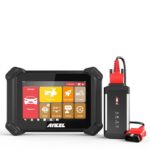Short drives prevent your Honda Pilot’s battery from fully recharging, necessitating frequent jump starts or the use of a battery maintainer like the NOCO Genius5. But what if opening the hood to connect directly to the battery isn’t an option? Obd2 Charging, using an adapter like the NOCO GC012, offers a convenient alternative. However, safety concerns arise regarding the OBD2 port’s fuse rating and its connection to the Engine Control Unit (ECU). This article explores the safety of OBD2 charging for a Honda Pilot, specifically focusing on these concerns.
Understanding OBD2 Charging Safety
NOCO, the manufacturer of the Genius5 and GC012 adapter, advises verifying two crucial factors before using OBD2 charging:
-
OBD2 Port Fuse Rating: The OBD2 port’s fuse must have a higher amperage rating than the charger’s output. The NOCO Genius5 outputs 5 amps, meaning the fuse needs to be rated higher than 5 amps to prevent it from blowing during charging.
-
ECU Connection: The OBD2 port should not be directly connected to the vehicle’s ECU. Charging through a direct connection could potentially damage sensitive electronic components within the ECU.
Honda Pilot OBD2 Port and Fuse Information
Determining the OBD2 port’s fuse rating and ECU connection for a specific Honda Pilot model requires consulting the owner’s manual or reliable online resources. Unfortunately, publicly available fuse box diagrams often lack clarity regarding the OBD2 port’s specific fuse. The lack of clear information necessitates further investigation. Consulting a Honda dealership or a qualified mechanic familiar with Honda Pilot electrical systems can provide definitive answers.
Best Practices for OBD2 Charging
Even with confirmation of a sufficient fuse rating and no direct ECU connection, adhering to best practices ensures safe OBD2 charging:
-
Consult Your Vehicle’s Manual: Always refer to your Honda Pilot’s owner’s manual for specific instructions and recommendations regarding OBD2 port usage.
-
Use a Reputable Adapter: Opt for a high-quality OBD2 charging adapter from a trusted manufacturer, like the NOCO GC012, designed for charging purposes.
-
Monitor the Charging Process: Regularly check the charger and the vehicle for any signs of overheating or unusual behavior.
-
Disconnect When Not in Use: Remove the adapter from the OBD2 port when not actively charging to prevent unnecessary drain on the vehicle’s electrical system.
Conclusion: Proceed with Caution
While OBD2 charging offers a convenient solution for maintaining your Honda Pilot’s battery, it’s crucial to verify the safety parameters before proceeding. Confirming the OBD2 port’s fuse rating and its connection to the ECU is paramount. When in doubt, consult a qualified professional for guidance. Prioritizing safety ensures the longevity of both your battery and your vehicle’s electrical system. Using the right equipment, understanding your vehicle’s specifics, and following best practices will help ensure a safe and effective charging experience.
